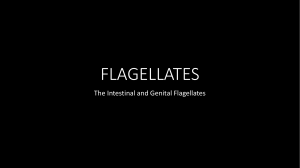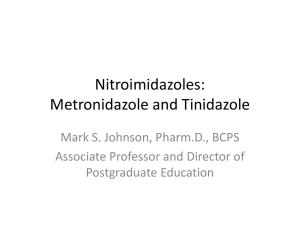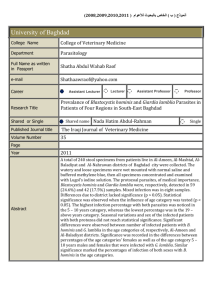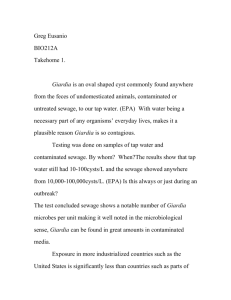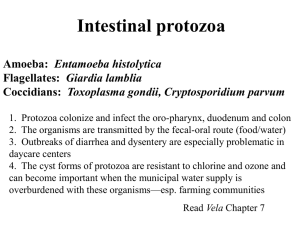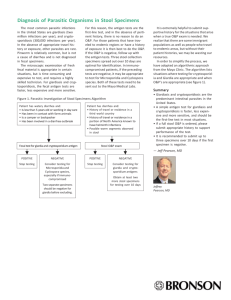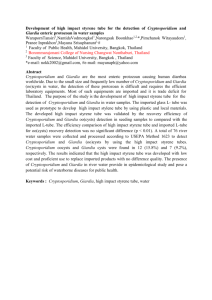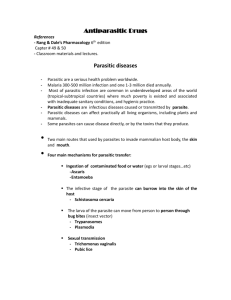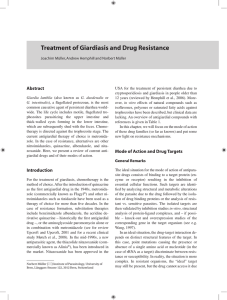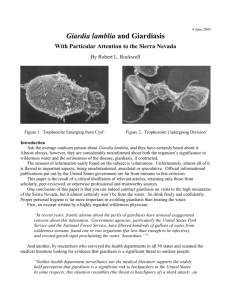ICMRP-14-192 - Global illuminators
advertisement
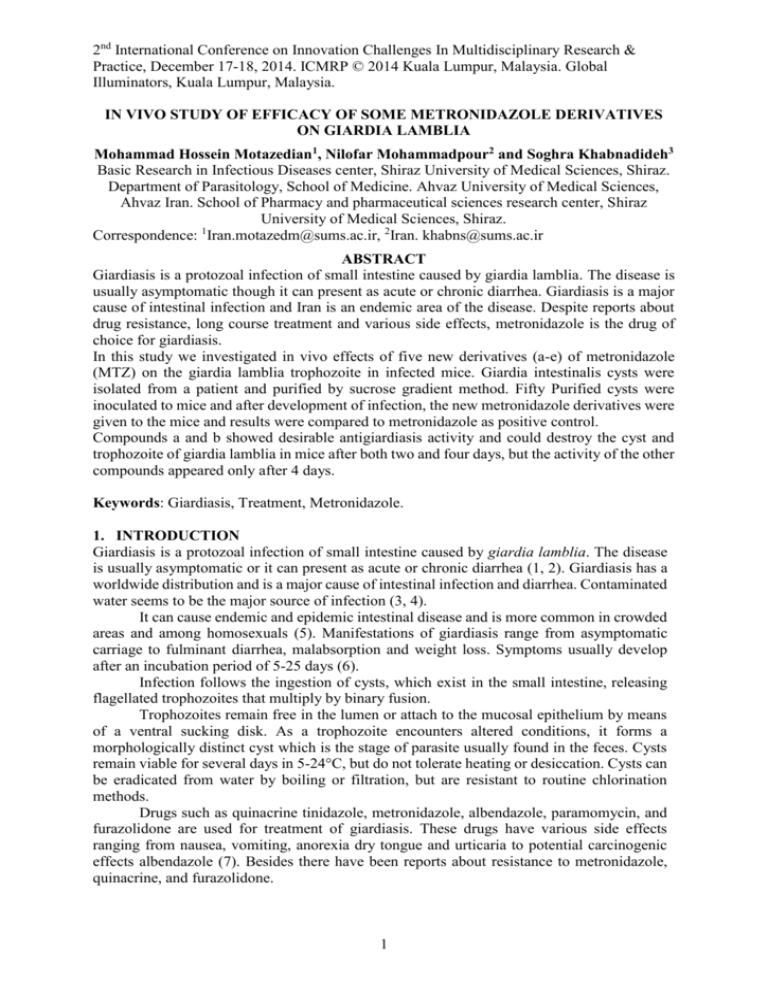
2nd International Conference on Innovation Challenges In Multidisciplinary Research & Practice, December 17-18, 2014. ICMRP © 2014 Kuala Lumpur, Malaysia. Global Illuminators, Kuala Lumpur, Malaysia. IN VIVO STUDY OF EFFICACY OF SOME METRONIDAZOLE DERIVATIVES ON GIARDIA LAMBLIA Mohammad Hossein Motazedian1, Nilofar Mohammadpour2 and Soghra Khabnadideh3 Basic Research in Infectious Diseases center, Shiraz University of Medical Sciences, Shiraz. Department of Parasitology, School of Medicine. Ahvaz University of Medical Sciences, Ahvaz Iran. School of Pharmacy and pharmaceutical sciences research center, Shiraz University of Medical Sciences, Shiraz. Correspondence: 1Iran.motazedm@sums.ac.ir, 2Iran. khabns@sums.ac.ir ABSTRACT Giardiasis is a protozoal infection of small intestine caused by giardia lamblia. The disease is usually asymptomatic though it can present as acute or chronic diarrhea. Giardiasis is a major cause of intestinal infection and Iran is an endemic area of the disease. Despite reports about drug resistance, long course treatment and various side effects, metronidazole is the drug of choice for giardiasis. In this study we investigated in vivo effects of five new derivatives (a-e) of metronidazole (MTZ) on the giardia lamblia trophozoite in infected mice. Giardia intestinalis cysts were isolated from a patient and purified by sucrose gradient method. Fifty Purified cysts were inoculated to mice and after development of infection, the new metronidazole derivatives were given to the mice and results were compared to metronidazole as positive control. Compounds a and b showed desirable antigiardiasis activity and could destroy the cyst and trophozoite of giardia lamblia in mice after both two and four days, but the activity of the other compounds appeared only after 4 days. Keywords: Giardiasis, Treatment, Metronidazole. 1. INTRODUCTION Giardiasis is a protozoal infection of small intestine caused by giardia lamblia. The disease is usually asymptomatic or it can present as acute or chronic diarrhea (1, 2). Giardiasis has a worldwide distribution and is a major cause of intestinal infection and diarrhea. Contaminated water seems to be the major source of infection (3, 4). It can cause endemic and epidemic intestinal disease and is more common in crowded areas and among homosexuals (5). Manifestations of giardiasis range from asymptomatic carriage to fulminant diarrhea, malabsorption and weight loss. Symptoms usually develop after an incubation period of 5-25 days (6). Infection follows the ingestion of cysts, which exist in the small intestine, releasing flagellated trophozoites that multiply by binary fusion. Trophozoites remain free in the lumen or attach to the mucosal epithelium by means of a ventral sucking disk. As a trophozoite encounters altered conditions, it forms a morphologically distinct cyst which is the stage of parasite usually found in the feces. Cysts remain viable for several days in 5-24°C, but do not tolerate heating or desiccation. Cysts can be eradicated from water by boiling or filtration, but are resistant to routine chlorination methods. Drugs such as quinacrine tinidazole, metronidazole, albendazole, paramomycin, and furazolidone are used for treatment of giardiasis. These drugs have various side effects ranging from nausea, vomiting, anorexia dry tongue and urticaria to potential carcinogenic effects albendazole (7). Besides there have been reports about resistance to metronidazole, quinacrine, and furazolidone. 1 2nd International Conference on Innovation Challenges In Multidisciplinary Research & Practice, December 17-18, 2014. ICMRP © 2014 Kuala Lumpur, Malaysia. Global Illuminators, Kuala Lumpur, Malaysia. Efforts have focused on the development of new, less toxic and more efficacious antigiardiasis drugs with novel mechanism of action. Even newer and less toxic antigiardiasis agents are available for clinical use, but their clinical efficacy in some invasive infections, is not optimal. In our previous works, we described the synthesis and also antigiardiasis activity of some new metronidazole compounds (8). As our new compounds showed desirable biological activity in higher concentration than metronidazole in this study we evaluated these new derivatives against infected mice by in vivo. 2. MATERIALS AND METHODS Cyst Purification Giardia lamblia cysts were isolated from a patient with heavy infection and 2% sucrose gradient flotation techniques were used for cyst purification. Collected cyst were washed twice and kept in refrigerator until use. For in vitro inoculation 100 white Syrian mice with (aged 3 to 6 month and weight, 23 to 27 g) were chosen, the entire mice were examined by formaldehyde ethyl acetate concentration for giardia infection. Forty cysts were inoculated to mice by gavages. After ten days mice stools were examined by formaldehyde ethyl acetate concentration for giardia infection and giardia lamblia cyst were found in 70% of them. Infected mice's were chosen and divided into 6 groups, each group consists of 10 mices. Five groups considered for the synthesized compounds and one group for MTZ positive control. Chemical Tested Compounds 2-(1H-1-imidazolyl)-1-phenyl-1-ethanol (a), 2-(2–methyl–1 H-1-imidazolyl)–1-phenyl-1ethanol (b), 2-(2-methyl-4-nitro-1H-1-imidazolyl)-1-phenyl-1-ethanol (c), 2-(1H-1imidazolyl)-1-cyclohexanol (d) and 1[bis-4-methoxyphenyl-phenylmethyl]-2-methyl-4nitroimidazole (e) were used for in vivo test. These compounds were synthesized according to the previously described procedure (8). After inducing the infection to the mices, each mice orally treated with (0.0125 mg/grams) of the new compounds for four days. Seven days after treatment, the treated mices were killed and their duodenum mucosal searched for giardia trophozoite. 3. RESULTS After infecting the mice with giardia lamblia, the new compounds were tested on them. 7-10 days after treatment, mices were killed and their intestines were examined for presence of cysts or trophozoites. Compounds a and b affected like MTZ and eradicated the cysts and trophozoites after both 2 and 4 days. Compounds c, d and e were effective after 4 days but viable trophozoites were detected in the intestines after 2 days Table 1. Table 1: Antigiardiasis effects of the tested compounds. Compds. a b c d e MTZ Chemica OH N N l O N O Structur es + + + 2 days + + + + + + 4 days OH N N N OH N N O - OH N HO N N O + N N O O - N N + + O - O 2 2nd International Conference on Innovation Challenges In Multidisciplinary Research & Practice, December 17-18, 2014. ICMRP © 2014 Kuala Lumpur, Malaysia. Global Illuminators, Kuala Lumpur, Malaysia. 4. DISCUSSION Several studies have so for investigated the efficacy of different drugs on giardia lamblia (912). These researchers tested the therapeutic effects of tinidazole, metronidazole, clotrimazole, miconazole, ketoconazole, and mebendazole on giardia lamblia trophozoites. Several of these have been approved for the treatment of giardiasis. Metronidazol, quinacrine, furazolidone, paromomycin, nitazoxanide 5-nitroimidazole and benzimidazole derivatives, are the most commonly used and had the best inhibitory effects on growth & adhesion of the parasite (11, 13). Metronidazole & tinidazole are toxic for anaerobic microorganisms such as giardia lamblia and have shown significant in vitro effects on the parasite (14). Unfortunately there are some reports in human patients and in vitro resistance to some of these compounds, including metronidazole (13, 15). Failure to treatment with metronidazole the drug of choice has been reported, and it was found with more side effects in comparison to albendazole and furazolidone. Alizadeh et al (16) and sadjjadi et al (17) reported 23% and 10% resistance against metronidazole respectively. Approach for finding new drugs to overcome resistance and side effect are needed for control and treatment of giardidsis. In this study we evaluated our 5 new synthesized derivatives against giardia infection in mice in vivo. Our results showed compounds a and b which contain imidazole and 2-methyl imidazole ring as their azole ring respectively and an aromatic ring in their side chain are as effective as MTZ. According to our results substitution of a nitro group at 4 position of imidazole ring decreased the activity because compound c was not as effective as compounds a and b. Also substitution of a saturated ring or a bulk group in the side chain decreased the activity because compounds d and e were not as effective as compounds a and b. Although Kavousi (18) and Lӧfmark (14) showed that metronidazole is the best choise for giardiasis, our compounds (a and b) could be good candidate for new antigiardiasis agents but they need more evaluations in the point of toxicity and pharmacokinetic properties to establish their antigiardiasis activity. 5. ACKNOWLEDGEMENT The author would like to thank the Office of the Vice-Chancellor for Research of Shiraz University of Medical Sciences, for its financial support of this project. 6. REFERENCES 1. Saebi E. Clinical parasitology, protozoal diseases in Iran. Tehran: Aeeizh; 2011. 2. Pierce KK, Kirkpatrick BD. Update on human infections caused by intestinal protozoa. Curr Opin Gastroenterol. 2009;25(1):12-7. 3. Feng Y, Xiao L. Zoonotic potential and molecular epidemiology of Giardia species and giardiasis. Clin Microbial Rev. 2011;24(1):110-40. 4. Dib HH, Lu SQ, Wen SF. Prevalence of Giardia lamblia with or withoutdiarrhea in South East, South East Asia and the Far East. Parasitol Res. 2008;103(2):239-51. 5. Dwivedi KK, Prasad G, Saini S, Mahajan S, Lal S, Baveja UK. Enteric opportunistic parasites among HIV infected individuals: associated risk factors and immune status. Jpn J Infect Dis. 2007;60(2/3):76. 6. Bajer A. Cryptosporidium and Giardia spp. infections in humans, animals and the environment in Poland. Parasitol Res. 2008;104(1):1-17. 7. Reynoldson J, Thompson R, Horton R. Albendazole as a future antigiardial agent. Parasitol Today. 1992;8(12):412-4. 8. Khabnadideh S, Rezaei Z, Motazedian M, Eskandari M. Synthesis of metronidazole derivatives as antigiardiasis agents. Daru. 2007;15(1):17-20. 3 2nd International Conference on Innovation Challenges In Multidisciplinary Research & Practice, December 17-18, 2014. ICMRP © 2014 Kuala Lumpur, Malaysia. Global Illuminators, Kuala Lumpur, Malaysia. 9. Jokipii L, Jokipii AM. In vitro susceptibility of Giardia lamblia trophozoites to metronidazole and tinidazole. J Infect Dis. 1980;141(3):317-25. 10. Gillin FD, Diamond LS. Inhibition of clonal growth of Giardia lamblia and Entamoeba histolytica by metronidazole, quinacrine, and other antimicrobial agents. J Antimicrob Chemother. 1981;8(4):305-16. 11. Wright JM, Dunn LA, Upcroft P, Upcroft JA. Efficacy of antigiardial drugs. Expert Opin Drug Saf. 2003;2(6):529-41. 12. A Escobedo A, Cimerman S, Almirall P. An old drug against giardiasis: mebendazole as a treatment option. Infect Disord Drug Targets. 2011;11(1):94-5. 13. Lalle M. Giardiasis in the post genomic era: treatment, drug resistance and novel therapeutic perspectives. Infect Disord Drug Targets. 2010;10(4):283-94. 14. Löfmark S, Edlund C, Nord CE. Metronidazole is still the drug of choice for treatment of anaerobic infections. Clin Infect Dis. 2010;50(Supplement 1):S16-S23. 15. Upcroft P. Drug resistance in< i> Giardia</i>: clinical versus laboratory isolates. Drug Resist Updat. 1998;1(3):166-8. 16. Alizadeh A, Ranjbar M, Kashani K, Taheri M, Bodaghi M. Albendazole versus metronidazole in the treatment of patients with giardiasis in the Islamic Republic of Iran. East Mediterr Health J. 2006;12(5):548. 17. Sadjjadi S, Alborzi A, Mostovfi H. Comparative clinical trial of mebendazole and metronidazole in giardiasis of children. J Trop Pediatr. 2001;47(3):176-8. 18. Kavousi S. Giardiasis in infancy and childhood: a prospective study of 160 cases with comparison of quinacrine (Atabrine) and metronidazole (Flagyl). Am J Trop Med Hyg. 1979;28(1):19-23. 4

